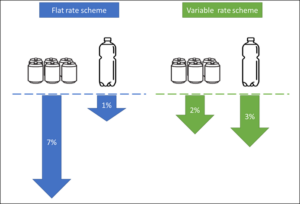| Practice area: | Behavioural Economics |
|---|---|
| Client: | N/A |
| Published: | 23 May, 2024 |
| Keywords: | behavioural consumer environment |
Deposit Return Schemes for homo-economicus
The European Parliament in April this year adopted new measures to make packaging more sustainable and reduce packaging waste in the EU.[i] As part of these new rules, by 2029 Member States are required to introduce deposit return systems for plastic and metal beverage containers. The UK Government, Welsh Government, Scottish Government and DAERA in Northern Ireland have agreed to launch a DRS in October 2027.[ii] Clio von Petersdorff from London Economics explores how the design of these policies impacts consumer behaviour for good and for bad, and the importance of considering behavioural biases when designing environmental policies.
Photo by the blowup on Unsplash
Deposit return schemes (also referred to as deposit refund systems) exist in a number of countries, and are becoming increasingly popular as the world battles to reduce waste and boost recycling rates. The idea is that consumers pay a small additional fee (“deposit”) on their beverages, which they can reclaim when they return the empty container (“refund”). The UK Government, Welsh Government, Scottish Government and DAERA in Northern Ireland have agreed to launch a DRS in October 2027.
The goal of these policies is to reduce littering and landfilling by increasing the recycling rates of plastic, aluminium and glass drinking containers, however, the levels of success of DRS schemes has been varied. This is partly because there are so many different ways in which the system can be set up. Some of the questions policy makers face when deciding to implement a deposit return scheme are: How high should the deposit be? What type of beverages and materials should be included? And who bears the cost of running the scheme? All of these factors play a role in how successful the deposit return scheme will be.
Another important factor to consider is whether or not the price of a deposit should vary according to the size of the beverage. Should a small can of beverage have the same deposit level as a 2 litre bottle? If people were perfectly rational, this would be a moot question; it wouldn’t matter whether the deposit on a can was the same as the deposit on a large bottle because it’s a deposit– which means that they would invariably get it back. But behavioural economics shows us that people don’t always act the way predicted by fully rational models of behaviour.
Let’s say someone was buying cola for a party and they were choosing between buying a 24 pack of cans (7.9 litres) or four large bottles (8 litres). A flat rate deposit of 20p on all containers will add 80p to their shop, but buying cans will add £4.80 at the till. This means that the average price of a 6-pack of beverage would increase by 60% compared to a 13% price increase of a 2 litre bottle. If the person knows that they will return all of the containers this initial outlay might not bother them, but if the person is unsure, or they have a limited budget for the party, they might choose to buy large PET bottles as the £4.00 is worth more to them now than it will be next week when they return the containers.
For the same amount of beverage, a larger deposit is required for aluminium cans compared to PET bottles with a flat rate scheme:
In 2020, London Economics modelled the impact of implementing a variable rate deposit return scheme (the deposit is dependent on the size of the container) compared to a fixed rate deposit return scheme (the deposit is the same for all container sizes).[iii] In both types of schemes the sales volume of beverages is reduced initially as consumers adjust to the new scheme however, aluminium cans and plastic bottles are impacted differently in each type of scheme.
The modelling undertaken by the London Economics study team found that introducing a fixed deposit scheme in the UK would decrease the total number of cans sold by almost 7% and the number of PET bottles by under 1% over the first 5 years of the scheme. Implementing a variable rate DRS, however, would reduce the number of cans sold by 1.6% and the number of PET bottles by 2.8% over the first 5 years of the scheme. These results imply that consumers may start switching to buying larger containers when a flat rate deposit return scheme is introduced.
The sales of beverage containers will be impacted differently depending on the design of the scheme:
Unintended impact
Although the impact on demand for cans and PET bottles is likely to decrease as consumers become more acquainted with the deposit return scheme, the shift away from cans to larger PET bottles may also have negative implications for the environment and even for people’s health.
How could a flat rate scheme impact people’s health?
Behavioural studies[iv], [v], [vi] have shown that when consumers buy larger portions of food, they tend to consume more. This is known as the ‘portion size effect’, and it implies that people may end up drinking more of the drink in one go than they usually would when they switch away from cans to large bottles. In the UK, nearly two-thirds of people older than 16 are overweight or obese and an estimated 20% of daily calories come from beverages.[vii] A policy that leads to people buying larger portions may lead to an increase in public health costs associated with obesity, including cardiovascular disease, type 2 diabetes, and certain cancers.[viii]
How could a flat rate scheme impact food waste?
According to the consumer survey run by London Economics, consumers state that they tend to waste larger proportions of drinks from large bottles compared to cans. Food and drink waste not only results in a financial loss of £60 per month for an average family in the UK[ix], but also has a significant environmental impact. The Waste and Resources Action Programme (WRAP) in the UK estimate that approximately 3.3 tonnes of CO2 equivalent are released for every tonne of drink that is wasted.[x]
How could a flat rate scheme impact the environment?
Aluminium has a recycling advantage over PET as it can be recycled indefinitely without the quality of the material degrading. In other words, the aluminium from a can could theoretically be turned back into a can over and over again without losing its quality, while the PET from plastic bottles can only be downcycled, and will be turned into items such as clothing or carpets which eventually end up in landfills or incinerated. The amount of energy required to recycle aluminium and the carbon emissions that arise are much lower than for PET, making aluminium a better candidate for the circular economy.[xi]
How can we ensure that policies don’t lead to unintended consequences?
It is vital that governments introduce policies that reduce our impact on the environment and promote a circular economy. Deposit return schemes are a great example of how consumers can be incentivised to recycle and be more sustainable, however, it is important to always keep the human element in mind when designing these policies. The quirks that make us different from the rational homo-economicus may cause even the most well-meaning policies to lead to unexpected and unintended outcomes.
Clio von Petersdorff is a Senior Economic Consultant at London Economics. She is interested in all things relating to the environment and human behaviour, and advises national governments and regulators, international organisations, and private companies across various sectors on using behavioural economics. She can be reached at [email protected].
[i] https://www.europarl.europa.eu/news/en/press-room/20240419IPR20589/new-eu-rules-to-reduce-reuse-and-recycle-packaging [ii]https://www.gov.uk/government/publications/deposit-return-scheme-for-drinks-containers-policy-statements/deposit-return-scheme-for-drinks-containers-joint-policy-statement [iii] Full report can be accessed here: https://alupro.org.uk/sustainability/deposit-return-scheme-report/. London Economics also completed a similar study on a DRS in Romania: https://londoneconomics.co.uk/wp-content/uploads/2021/12/Alucro_Executive-Summary-published-Dec-2021.pdf [iv] Chandon, P., & Wansink, B. (2012). Does food marketing need to make us fat? A review and solutions. Nutrition reviews, 70(10), 571-593 [v] Hetherington, M. M., & Blundell‐Birtill, P. (2018). The portion size effect and overconsumption–towards downsizing solutions for children and adolescents. Nutrition Bulletin, 43(1), 61-68. [vi] World Health Organisation (WHO) (2015). Portion, package or tableware size for changing selection and consumption of food, alcohol and tobacco. Cochrane database of systematic reviews, (9). [vii] Ng, S. W., Ni Mhurchu, C., Jebb, S. A. and Popkin, B. M., (2012). Patterns and trends of beverage consumption among children and adults in Great Britain, 1986-2009. British Journal of Nutrition. 108(3), 536-51 [viii] British Heart Foundation. (2015). Policy statement: Sugary sweetened beverages tax. [ix] Wrap (2018). Food surplus and waste arisings in the UK. Available at https://www.wrap.org.uk/sites/files/wrap/Estimates_%20in_the_UK_Jan17.pdf [x] Wrap (2012). Methods used for Household Food and Drink Waste in the UK. Available at https://www.wrap.ngo/resources/report/household-food-and-drink-waste-united-kingdom-2012 [xi] Department of Engineering, University of Cambridge (2011) Packaging and Recycling. Available at: http://www-materials.eng.cam.ac.uk/energyforschools/downloads/D-PackagingRecycling.pdf
Behavioural scientists refer to these quirks as “heuristics” and “biases”.




